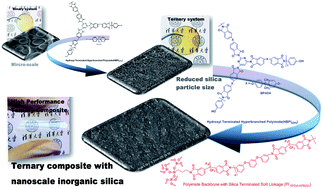Ternary composites of linear and hyperbranched polyimides with nanoscale silica for low dielectric constant, high transparency, and high thermal stability
Abstract
A new series of ternary polyimide–silica composites was developed to obtain polymer films with low dielectric constant, high optical transparency, and good thermal stability. By using a linear polyamic acid with triethoxysilane termini and a hyperbranched polyimide with peripheral hydroxyl groups (HBPIBPADA-TAP(OH)), the ternary composites were fabricated through in situ imidization and sol–gel reaction with tetraethoxysilane. The results show that the composite films exhibit significantly improved properties due to the strong silica cross-linkages between organic–inorganic phases. The triethoxysilane termini can effectively enhance transparency because of the homogeneous dispersion of the inorganic phase in the PI matrices and the improved dispersibility through their strong covalent and partial hydrogen bonding with inorganic silica networks. With an appropriate content of 30% HBPIBPADA-TAP(OH) and 20% SiO2 in the linear polyimide (PI6FDA-APB(Si)), the dielectric constant (Dk) can reach the lowest value of 2.19 at 100 kHz. The highest transmittance of 96% at 450 nm is obtained for a ternary hybrid containing 20% SiO2 and 10% HBPIBPADA-TAP(OH). The incorporation of HBPIBPADA-TAP(OH) does not cause negative effects on the thermal stability. The ternary hybrid containing 20% SiO2 and 10% HBPIBPADA-TAP(OH) also exhibits the lowest coefficient of thermal expansion (CTE) of 27.8 ppm °C−1, when compared with 29.9 ppm °C−1 for the binary composite as PI6FDA-APB(Si) with 20% SiO2. These properties can well match the requirements for potential applications in the microelectronics insulator fields as interlayer dielectrics of advanced electronic devices.


 Please wait while we load your content...
Please wait while we load your content...